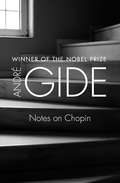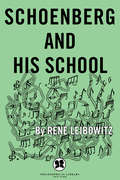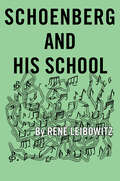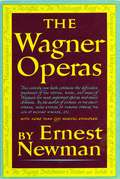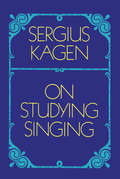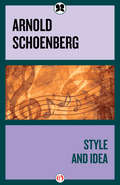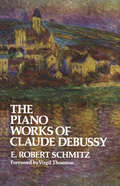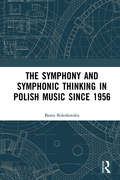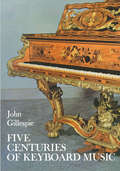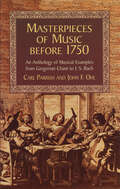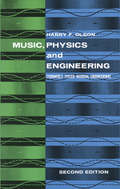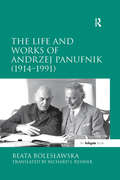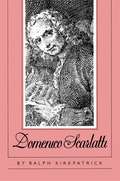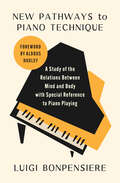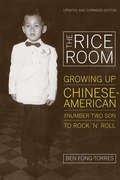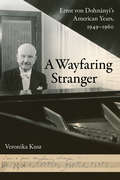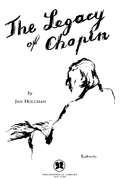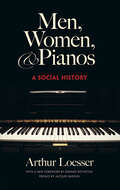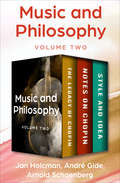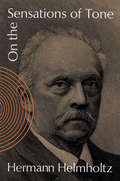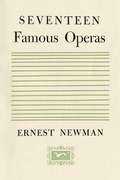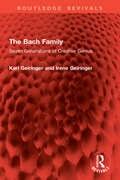- Table View
- List View
Notes on Chopin
by André GideAn inspiring discourse on the power of music from one of the twentieth century&’s most important figures, André Gide André Gide, one of the great intellectuals of the twentieth century and a devoted pianist, invites readers to reevaluate Frédéric Chopin as a composer &“betrayed . . . deeply, intimately, totally violated&” by a music community that had fundamentally misinterpreted his work. As a profound admirer of Chopin&’s &“promenade of discoveries,&” Gide intersperses musical notation throughout the text to illuminate his arguments, but most moving is Gide&’s own poetic expression for the music he so loved. This edition includes rare pages and fragments from Gide&’s journals, which relate to Chopin and music.
Notes on Chopin
by André GideAn inspiring discourse on the power of music from one of the twentieth century&’s most important figures, André Gide André Gide, one of the great intellectuals of the twentieth century and a devoted pianist, invites readers to reevaluate Frédéric Chopin as a composer &“betrayed . . . deeply, intimately, totally violated&” by a music community that had fundamentally misinterpreted his work. As a profound admirer of Chopin&’s &“promenade of discoveries,&” Gide intersperses musical notation throughout the text to illuminate his arguments, but most moving is Gide&’s own poetic expression for the music he so loved. This edition includes rare pages and fragments from Gide&’s journals, which relate to Chopin and music.
Schoenberg and His School
by René Leibowitz Dika NewlinIn Schoenberg and His School, René Leibowitz performs a threefold task. He relates the music of Schoenberg and his followers to the age-old tradition of Western polyphony, of which, he says, it is but the latest product. He discusses, with numerous musical examples, all known major works of Schoenberg and of his two great disciples Alban Berg and Anton Webern. And, in the final section of the book, he considers what the tradition represented by these three men could bring to the future, if carried still further by the young composers of today. Contents: Prolegomena to Contemporary Music; Arnold Schoenberg: The Origins and Foundations of Contemporary Music; Alban Berg: The Awareness of the Past in Contemporary Music; Anton Webern: The Awareness of the Future in Contemporary Music; The Structure of Contemporary Musical Speech.
Schoenberg and His School
by René LeibowitzThe noted music theorist presents a brilliant and sweeping study of Schoenberg&’s compositions and his influence on the generations that followed. A pioneering composer and leader of the Second Viennese School, Arthur Schoenberg was one of the most important figures in twentieth-century classical music. In Schoenberg and His School, composer, conductor, and music theorist René Leibowitz offers an authoritative analysis of Schoenberg&’s groundbreaking contributions to composition theory and Western polyphony. In addition to detailing his subject&’s major works, Leibowitz also explores Schoenberg&’s influence on the works of his two great disciples, Alban Berg and Anton Webern. Leibowitz considers how the influences of all three men have, in turn, created new movements within contemporary music today.
The Wagner Operas
by Ernest NewmanIn this classic guide, the foremost Wagner expert of our century discusses ten of Wagner's most beloved operas, illuminates their key themes and the myths and literary sources behind the librettos, and demonstrates how the composer's style changed from work to work. Acclaimed as the most complete and intellectually satisfying analysis of the Wagner operas, the book has met with unreserved enthusiasm from specialist and casual music lover alike. Here, available for the first time in a single paperback volume, is the perfect companion for listening to, or attending, The Flying Dutchman, Tannhäuser, Lohengrin, Tristan and Isolde, Die Meistersinger, the four operas of the Ring Cycle, and Parsifal. Newman enriches his treatment of the stories, texts, and music of the operas with biographical and historical materials from the store of knowledge that he acquired while completing his numerous books on Wagner, including the magisterial Life of Richard Wagner. The text of The Wagner Operas is filled with hundreds of musical examples from the scores, and all the important leitmotifs and their interrelationships are made clear in Newman's lucid prose. "This is as fine an introduction as any ever written about a major composer's masterpieces. Newman outlines with unfailing clarity and astuteness each opera's dramatic sources, and he takes the student through the completed opera, step by step, with all manner of incidental insight along the way. "--Robert Bailey, New York University
On Studying Singing (Dover Books On Music: Voice)
by Sergius Kagen"Logical, clear, convincing, and, in my modest judgment, dead right." -- Virgil Thomson, New York Herald Tribune"I recommend this volume highly." -- Maggie Teyte, Saturday Review"One of the most sensible books on the subject of vocal art." -- Felix Borowski, Chicago Sun-TimesThis book is an invaluable guide for the student, parent, teacher, coach, or any person connected with vocalism. It is not intended to teach the student how to sing since no book could possibly do this. Its main purpose is to help him find a way to study singing intelligently.The author, who is a member of the faculty of the Juilliard School of Music and a prominent musician with a vast experience of teaching singers, explains in this book clearly and logically just what a student can and cannot expect from singing lessons. He also discusses in detail the various subsidiary studies necessary to the singer, such as the study of musical notation and theory, ear training, languages, and other allied subjects.Particularly useful and interesting is the section dealing with various methods employed in teaching vocal technique. In this section, Mr. Kagen debunks the so-called "scientific methods" of voice teaching and the concept of "building voices" -- follies which have often led to an enormous waste of money, time, and effort.
Style and Idea: Selected Writings Of Arnold Schoenberg
by Arnold SchoenbergIn these enlightening essays, the Austrian composer and music theorist presents his vision of how music speaks to us and what it is capable of saying. This book is full of essays which Arnold Schoenberg wrote on style and idea. He talks about the relationship to the text, new and outmoded music, composition in twelve tones, entertaining through composing, the relationship of heart and mind in music, evaluation of music, and other essays.
The Piano Works of Claude Debussy (Dover Books on Music)
by E. Robert SchmitzThis book is a firsthand report of a great composer's intentions in regard to the performance of his music. These intentions have been digested and interpreted for us by the composer's friend Robert Schmitz (1889–1949), who was himself a distinguished pianist, an articulate musician, and a well-known teacher. The product is an authoritative commentary on the entire body of Debussy's work for piano solo.Written for both performers and listeners, the book's purpose is to increase enjoyment of and insight into these works. The book's shorter opening section comprises notes on many general aspects of the composer's life and work; a biographical sketch; a discussion of Debussy's place in relation to the concepts of impressionism and romanticism; his use of classical forms, tonality and modality, melody, counterpoint, etc. Section two, the heart of the book, examines in detail the whole of Debussy's music for solo piano, two hands. Seventy-one pieces in all are included: The Arabesques, the Suite Bergmasque, the Estampes, Images, Children's Corner, Préludes and Études. Each in its chronological place, the pieces are first described as a whole as to mood, source of programmatic inspiration, structure, tonality, and other characteristics. Then follows specific suggestions dealing with technical and expressive problems of particular measures and phrases.The book is not meant as a substitute for Debussy's piano works; on the contrary, it will cause both listeners and performers to turn to this superb corpus of music with new interest and insight. "Complete, thorough, authoritative and important." — San Francisco Chronicle. "It is a thoughtful and mature reference book and though I am at variance with certain of its premises and conclusions, there is much to provoke the intelligent music lover and the inquiring musician." — Abram Chasins, The New York Times. "There is no doubt that he had closely identified himself with the great French composer, and his love and belief in the music shine through every page of this book." — H. C. Schonbert, The Saturday Review.
The Symphony and Symphonic Thinking in Polish Music Since 1956
by Beata Bolesławska1956 was a year of transition in Poland, and an important year for Polish music. This year saw the beginning of a political thaw – sometimes called the Polish October – in communist Poland. It was also the year of the establishment of the 'Warsaw Autumn' International Festival of Contemporary Music. This was a time of great artistic ferment in Polish music, which also deeply influenced symphonic thinking. The year 1956 is thus an appropriate starting point for Beata Bolesławska’s study of the contemporary Polish symphonic tradition. Bolesławska investigates the influential Polish avant-garde, illuminating the ways in which new musical means and ideas influenced symphonic music and the genre of the symphony in the music of such important composers as Witold Lutosławski (1913–1994), Henryk Mikołaj Górecki (1933–2010) and Krzysztof Penderecki (b. 1933). Referring to the main elements of the European tradition, as well as examining briefly the symphonic activity in Poland before 1956, the book concentrates on the symphonic writing in the context of avant-garde trends, represented by the so-called 'Polish school of composers', as well as on its later redefinitions proposed by Polish composers up to the present day.
Five Centuries of Keyboard Music (Dover Books On Music: Piano)
by John GillespieMost listeners can readily distinguish between the works of such keyboard giants as Bach, Beethoven, and Liszt and between various national schools, but when it comes to defining what the differences are, relating the various interconnections, discovering information on the hundreds of other keyboard composers, and actually finding playing editions, the task becomes much greater. To aid the performer, the listener, and the student in all these important aspects, John Gillespie, practicing pianist and harpsichordist and Professor of Music at the University of California, has prepared this, the first work in English to comprehensively survey the development of solo keyboard works.Introductory chapters of Gillespie's literate and authoritative survey cover the backgrounds and development of keyboard instruments and early keyboard music. Later chapters cover the history as it progressed stylistically through the hands of individual composers and various schools from the sixteenth to the twentieth centuries. Emphasis is given to the masters whose works continue to be heard most often today -- Bach, Handel, Mozart, Haydn, Beethoven, Schubert, Schumann, Brahms, Liszt, Chopin, Debussy, Ravel, and others. Major consideration, too, is given to composers who were influential in developing national styles. All of the Western countries -- from Germany, Italy, France, and England to Norway, Russia, the United States, South America, and Canada -- are included. Finally, there are discussions of now little-known composers who were important in their times. Altogether over 350 composers are discussed. Important, also, in John Gillespie's survey are his various other aids -- guides to a carefully selected body of playing editions and other historical works, a great number of musical illustrations, and a 195-item glossary of musical terms.Individual chapters and articles will be helpful in quickly locating information about particular composers, schools, and works. Footnotes and bibliographies will be important for the performer, student, or professional looking for either playing editions or further information. The book as a whole, however, when read as it should be from cover to cover, will give the reader a very good understanding of the development of works for the solo keyboard, of the traditions, and the interconnections, with accurate coverage from the first known works of the sixteenth century up to the exciting modern composers.
Masterpieces of Music Before 1750 (Dover Books On Music: History)
by John F. Ohl Carl ParrishAnyone interested in the history and development of Western music will welcome this collection of outstanding musical examples illustrating the general course of musical style from the early Middle Ages to the mid-eighteenth century. Included are 50 carefully selected compositions of great historical importance -- each masterful and beautiful in its own right.Selections include chants, the organum, parts of masses, motets, chansons, canzonas, lute dances, madrigals, ricercari, and clavecin pieces. Among the pieces are exquisite motets by Josquin, Lassus, and Byrd; madrigals by Marenzio and Caccini; brilliant instrumental displays by Frescobaldi, Pachelbel, Couperin, and Domenico Scarlatti; choral music by Handel and Bach, and much more.Each example is accompanied by notes that identify the place of the composition in the history of music and suggest ways for the reader to undertake a useful analysis of that music. Most examples are in easy-to-follow "short score" -- i.e., in two staves, lending themselves to analysis and performance by the student singly or in informal ensembles. The music can be performed either vocally or at the keyboard, allowing the reader to gain unmatched insight into the character and significance of a rich cross-section of historic styles.
Music, Physics and Engineering (Dover Books On Music Ser.)
by Harry F. OlsonNow thoroughly revised and enlarged, this book offers the most comprehensive coverage available of all aspects of the production, reception, and reproduction of sound. Written clearly and concisely, all its chapters can be understood without specialized training in music, physics, engineering, or mathematics.Dr. Olson discusses the nature of sound waves; explains the division of sound into scale patterns and the traditional method of notating them; describes the individual characteristics of all musical instruments currently in use (including the human voice); shows how the ears hear; discusses concert hall and recording studio acoustics, amplification systems, etc; describes the elements of sound reproduction systems from the telephone to the stereo record player; and concludes with a new chapter on the production, development, and potentialities of electronic music.Under these broad headings, readers will find a close analysis of the way in which a violin produces sound; descriptions of carbon, crystal, dynamic, velocity, and unidirectional microphones; a comparison of the relative absorbency of 22 acoustic materials, building materials, and objects; a description of how music can be produced by a digital computer; and much, much more. Conductors will find suggestions on positioning their orchestras; performers will understand the dynamics of their instruments; recording engineers and acousticians will discover a remarkably comprehensive reference work; and music teachers, students, physicists, and enthusiasts in general will find easy access to a vast wealth of information.
The Life and Works of Andrzej Panufnik (1914-1991)
by Beata Boles?awskaSir Andrzej Panufnik was born in Warsaw and studied in the newly independent Poland in the 1930s, as well as in Vienna and Paris just before the outbreak of the Second World War. During the German occupation he formed a piano duo with his friend and fellow composer Witold Lutoslawski, and they performed in caf�around Warsaw. After the war, Panufnik quickly established himself as a leading Polish composer, and as a conductor he played a significant role in the re-establishment of first the Krak�nd then the Warsaw Philharmonic. Although he was considered Poland�s leading composer for some years after the war, Panufnik was subsequently put under intolerable pressure both musically and politically. Frustrated by the continuing rejection of his compositions and the unending political demands inflicted on him by the country�s post-war Communist regime, he made a daring escape to England in 1954. He briefly became Principal Conductor of the City of Birmingham Symphony Orchestra, a post he relinquished after two years to devote all his time to composition. His works were in demand by major figures such as Leopold Stokowski who conducted the first performances of Sinfonia Elegiaca, Katyn Epitaph and Universal Prayer, Yehudi Menuhin who commissioned the Violin Concerto, Seiji Ozawa in Boston and Sir Georg Solti in Chicago who both commissioned symphonies for the centenaries of their famous orchestras; also Mstislav Rostropovich with the London Symphony Orchestra, who together commissioned the Cello Concerto. Beata Boleslawska has written the first book on the life and artistic output of Panufnik, setting his significance alongside the political and cultural scene of twentieth-century Europe. The account of the composer�s life is based on numerous archival documents, as well as the personal accounts contributed by his family and friends. Panufnik�s compositional style and techniques are also analysed. This book will be of interest not only to those devoted
Domenico Scarlatti (Alianza Musica Ser.)
by Ralph KirkpatrickAgain available in paperback, this definitive work on the genius of Domenico Scarlatti (1685-1757) is the result of twelve years of devoted effort by America's foremost harpsichordist and one of the principal authorities on eighteenth-century harpsichord music. Mr. Kirkpatrick traveled extensively to collect material that has tripled the known facts about Scarlatti's life, providing the first adequate biography of one of the greatest harpsichord composers of the eighteenth century and one of the most original composers of all time. The second half of his book is an illuminating study of Scarlatti's 555 sonatas, concluding with a chapter on their performance. The book contains extensive appendixes, including discussions of ornamentation and Scarlatti's vocal music, and an updated section of addenda and corrigenda.
New Pathways to Piano Technique: A Study of the Relations Between Mind and Body with Special Reference to Piano Playing
by Luigi BonpensiereReaders and musicians will find &“quite [a] revolutionary approach to the keyboard&” in this work that applies psychological principles to improve piano skill (Music & Letters). In 1931, composer, artist, and inventor Luigi Bonpensiere began exploring piano technique through a series of mind-body experiments. He devoted the next twelve years of his life to examining, recording, interpreting, and applying his findings. New Pathways to Piano Technique contains Bonpensiere&’s notes toward a piano practice grounded in ideokinesis. This revolutionary approach combines the somatic experience of the musician with visual imagery to improve musical skill fluidly and rapidly. With a foreword by Aldous Huxley, who calls Bonpensiere a &“remarkably gifted author,&” this pioneering work offers valuable philosophical and psychological insights on the practice of piano to contemporary music lovers and pianists.
The Rice Room: Growing Up Chinese-American from Number Two Son to Rock 'n' Roll
by Ben Fong-TorresAn instant best-seller when originally published in 1994, this expanded and updated edition of The Rice Room tells of growing up with a double identity—Chinese and American. Ben Fong-Torres was torn between an alluring American lifestyle—including Elvis and rock ‘n’ roll—and the traditional cultural heritage his proud immigrant parents struggled to instill in their five children. Now illustrated with personal family photographs as well as photos of the author with various celebrities, Fong-Torres rounds out his life story with a new final chapter.
A Wayfaring Stranger: Ernst von Dohnányi's American Years, 1949-1960 (California Studies in 20th-Century Music #25)
by Veronika KuszOn March 10, 1948, world-renowned composer and pianist Ernst von Dohnányi (1877−1960) embarked for the United States, leaving Europe for good. Only a few years earlier, the seventy-year-old Hungarian had been a triumphant, internationally admired musician and leading figure in Hungarian musical life. Fleeing a political smear campaign that sought to implicate him in intellectual collaboration with fascism, he reached American shores without a job or a home. A Wayfaring Stranger presents the final period in Dohnányi’s exceptional career and uses a range of previously unavailable material to reexamine commonly held beliefs about the musician and his unique oeuvre. Offering insights into his life as a teacher, pianist, and composer, the book also considers the difficulties of émigré life, the political charges made against him, and the compositional and aesthetic dilemmas faced by a conservative artist. To this rich biographical account, Veronika Kusz adds an in-depth examination of Dohnányi’s late works—in most cases the first analyses to appear in musicological literature. This corrective history provides never-before-seen photographs of the musician’s life in the United States and skillfully illustrates Dohnányi’s impact on European and American music and the culture of the time.
Legacy of Chopin
by Jan HolcmanChopin's views on all phases of music: pianism, composing, teaching, piano transcriptions, criticism, musical progress, etc.
Men, Women & Pianos
by Arthur LoesserSome of the greatest composers of history have confined some of their most precious thoughts to the piano. For a century and a half, series of pianists of outstanding nimbleness and expressive power have attracted millions of admirers to their performances. Mozart, Beethoven and Chopin, Liszt, Rubinstein and Rachmaninov, to achieve the fulfillment of their art, needed to have pianos. From where did they get them? From factories, of course. But piano factories cannot stay in business simply by making a few instruments for a few great musicians. They must sell their products annually by the hundreds, by the thousands, to all manner of persons: doctors, lawyers, merchants, government officials. What did those persons want with pianos? This book may supply some answers to this question." That is the modest raison d'être for his book given by the author in a letter to the publisher. But any reader will see at once that the proliferations in the answer to his question result in something much more important and delightful. What Mr. Loesser has written is really a piano's-eye view of the social--and sometimes the philosophical--history of Western Europe and the United States from the seventeenth century to the present, with glances both forward and back. With a keen eye for both the ridiculous and the significant detail (which turn out often to be the same thing), he traces the history of the design and manufacture of the piano, and the music written for it, from its predecessors, the clavichord and the virginal, to the latest concert grand and the modern "spinet." Long established as an internationally known concert pianist, Mr. Loesser here shows himself to be an elegant stylist and an impressively learned scholar, who has the wit to see that in a social history the role of the interior decorator may be quite as important as that of the virtuoso--and that of the ambitious parent, more important than either.
Men, Women and Pianos: A Social History
by Arthur LoesserA piano's-eye view of the social and philosophical history of Western Europe and the United States from the 17th century to the 1950s, with glances forward and back.
Men, Women and Pianos: A Social History
by Arthur LoesserAs the "social anchor" in middle-class homes of the nineteenth century, the piano was simultaneously an elegant piece of drawing-room furniture, a sign of bourgeois prosperity, and a means of introducing the young to music. In this admirably balanced and leisurely account of the popular instrument, the late, internationally known concert pianist Arthur Loesser takes a "piano's-eye view" of the recent social history of Western Europe and the United States.Drawing on newspapers, music manuscripts, popular accounts, and other sources, Loesser traces the history of the piano from its predecessors, the clavichord and the harpsichord, to the modern spinet and concert grand. Chapter headings such as "Clavichords Make Weeping Easier," "The Harpsichord Grows Feet," "The More Pianos the Merrier," and "The Keyboards Go West" suggest the author's lighthearted approach to topics ranging from the piano's European origins and its introduction in the United States to the decline of piano manufacturing in the early twentieth century and the "victory of airborne music" by mid-century. A preface by historian Jacques Barzun and a new foreword by music critic Edward Rothstein enhance a volume rich in wit and knowledge -- one that will delight any reader with an interest in the piano and on Western cultural history.
Music and Philosophy Volume Two: The Legacy of Chopin, Notes on Chopin, and Style and Idea
by André Gide Jan Holcman Arnold SchoenbergThese three texts explore the power and potential of music by a renowned musicologist, a celebrated composer, and a Nobel Prize–winning author. Jan Holcman&’s The Legacy of Chopin is a comprehensive study of the great composer&’s views on music—including pianism, composition, pedagogy, criticism, and more. Drawing on extensive research from a wide range of sources, Holcman provides essential historical and musicological context for Frederic Chopin&’s references and concepts, making his more esoteric ideas accessible to the general reader. Nobel Prize winning author and devoted pianist André Gide presents inspiring discourse on the power of Chopin&’s music in Notes on Chopin. Gide depicts Chopin as a composer &“betrayed . . .deeply, intimately, totally violated&” by a music community that had fundamentally misinterpreted his work. Notes is a moving and poetic expression of profound admiration for a pioneering composer, and this edition includes rare pages and fragments from Gide&’s journals. In Style and Idea, Austrian composer and music theorist Arnold Schoenberg presents his vision of how music speaks to us and what it is capable of saying. Through a series of essays, Schoenberg discusses the relationship between music and language, new and outmoded music, composition in twelve tones, entertaining through composing, the relationship of heart and mind in music, evaluation of music, and other topics.
On the Sensations of Tone: As A Physiological Basis For The Theory Of Music (classic Reprint) (Dover Books on Music)
by Hermann HelmholtzOn the Sensations of Tone is one of the world's greatest scientific classics. It bridges the gap between the natural sciences and music theory and, nearly a century after its first publication, it is still a standard text for the study of physiological acoustics -- the scientific basis of musical theory. It is also a treasury of knowledge for musicians and students of music and a major work in the realm of aesthetics, making important contributions to physics, anatomy, and physiology in its establishment of the physical theory of music. Difficult scientific concepts are explained simply and easily for the general reader.The first two parts of this book deal with the physics and physiology of music. Part I explains the sensation of sound in general, vibrations, sympathetic resonances, and other phenomena. Part II cover combinational tones and beats, and develops Helmholtz's famous theory explaining why harmonious chords are in the ratios of small whole numbers (a problem unsolved since Pythagoras).Part III contains the author's theory on the aesthetic relationship of musical tones. After a survey of the different principles of musical styles in history (tonal systems of Pythagoras, the Church, the Chinese, Arabs, Persians, and others), he makes a detailed study of our own tonal system (keys, discords, progression of parts).Important points in this 576-page work are profusely illustrated with graphs, diagrams, tables, and musical examples. 33 appendices discuss pitch, acoustics, and music, and include a very valuable table and study of the history of pitch in Europe from the fourteenth to the nineteenth centuries.<P><P>Advisory: Bookshare has learned that this book offers only partial accessibility. We have kept it in the collection because it is useful for some of our members. To explore further access options with us, please contact us through the Book Quality link on the right sidebar. Benetech is actively working on projects to improve accessibility issues such as these.
Seventeen Famous Operas
by Ernest Newman“The great composer does not set to work because he is inspired, but becomes inspired because he is working.” –Ernest Newman In Seventeen Famous Operas, renowned musicologist and music critic Ernest Newman goes beyond simply retelling the plots of the operas he has chosen to feature in this volume. Because for Newman, opera was theater—and he demonstrates that with his in-depth studies of the seventeen featured operas. Newman uses biographical, literary, and historical background to expose the reader to how each featured work came to be. These featured works include La Boheme, Madame Butterfly, Carmen, La Traviata, The Marriage of Figaro, The Barber of Seville, The Magic Flute and ten other famous works. Seventeen Famous Operas is a must-read for music librarians, opera lovers, and propagandists of music everywhere.
The Bach Family: Seven Generations of Creative Genius (Routledge Revivals)
by Karl Geiringer Irene GeiringerWhen this volume was originally published in 1954 it was the first complete history of the Bach family from the 16th Century miller Veit to Wilhelm Friedrich Ernst (1759-1845), Johann Sebastian’s grandson. The author views the family as a whole and shows the characteristic similarities in their artistic and human attitudes as well as the most significant divergences. Equal stress is laid on the discussion of the personalities, against the swiftly changing historical scene, and on the music, for which the author was able to use vast, hitherto inaccessible material. Apart from describing the fascinating phenomenon of this musical family, the author gives a history of musical thought in the last 300 years.
